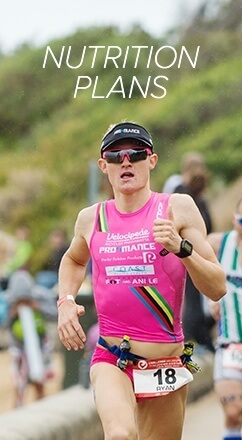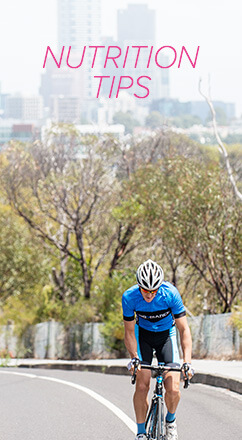CALCULATING WATER LOSS DURING EXERCISE
Acute changes in body weight during exercise can be used to calculate sweating rates that occur in different environments (Cheuvront et al., 2002). This approach assumes that 1mL of sweat loss represents a 1g loss in body weight. The before exercise body weight measures are used with the post exercise body weight measurements (Cheuvront et al., 2002). Athletes should weigh themselves prior to training/competing in minimal clothing. Immediately post training/competing, they should weigh themselves again in identical dry clothing on the same set of scales. The differences between pre and post exercise body weight should be consumed at 125-150% to ensure optimal hydration (AIS Sports Nutrition, 2009)
Example:
Pre-exercise weight – 70 kg
Post-exercise weight – 68.5 kg
Fluid deficit (L) = 70 kg – 68.5 kg = 1.5 kg
Total sweat loss (L) = 1.5 kg = 1.5L sweat loss
Water consumption need to rehydrate (L) = 1.875L (125%) or 2.25L (150%)
It is important an athlete rehydrates with a post exercise recovery drink that containing electrolyte to ensure fluid retention post exercise. Electrolytes within a post-exercise recovery drink allow a state of hyperhydration up to 6 hours after fluid is ingestion when an athlete has consumed either 125% or 150% of their sweat loss (Nielsen et al., 1986).
To calculate average water loss per hour athletes should compare the differences between pre and post exercise body weight measurements corrected for urine losses and drink volume (Cheuvront et al., 2002). This will help an athlete ensure they rehydrate correctly during exercise periods in which they cannot measure the body weight measurement changes during the exercise period.
Example:
Pre-exercise weight – 70 kg
Post-exercise weight – 68.5 kg
Volume of fluid consumed during exercise (2 L) – 2 kg & estimated urine losses – 500ml
Exercise duration – 2 hrs
Fluid deficit (L) = 70kg – 68.5kg = 1.5 kg
Total sweat loss (L) = 1.5 kg + 2 kg – 500ml = 3kg (3L sweat loss)
Sweat rate (L/h) = 3 kg/2 h = 1.5 L/h
The athlete should drink 1.5L of fluid per hour that they have exercised.
REFERENCE:
AIS Sports Nutrition. (2009). Australian Sports Commission. Retrived from http://www.ausport.gov.au/ais/nutrition/factsheets/competition_and_training2/recovery_nutrition
Cheuvront, S.N., Haymes, E.M., & Sawka, M.N. (2002). Comparison of swear loss estimates for women furing prolonged high intensity running. Medicine and Science in Sports and Exercise, 34, 1344-1350.
Nielsen, B., Sjogaard, G., Ugelvig, J., Knudsen, B., & Dohlmann, B. (1986). Fluid balance in exercise dehydration and rehydration with different glucoseelectrolyte drinks. European Journal of Applied Physiology, 55, 318–325.
FLUID AND EXERCISE
Exercise results in loss of water from the body via evaporation of water from the lungs and sweating of water from the skin. For exercise of sufficient duration and intensity, the losses reduce the volume of blood available for the heart to pump to the muscles and skin. Reduction of blood flow to muscles implies less delivery of oxygen to the muscles, so endurance performance declines. Reduction of blood flow to the skin implies less elimination of heat from the body, so the risk of heat stroke (damage to cells and tissues from overheating) increases, especially in a hot or humid environment. The loss of water may also reduce production of sweat, which will also increase the risk of heat stroke. These effects become substantial for near-maximal exercise lasting an hour in a hot humid environment and two hours in a cool environment. (Hopkins & Wood, 2006)
There is a general consensus in the literature that dehydration should not exceed 2% of body weight loss during most athletic events (Noakes & Martin, 2002). Dehydration reduces heat dissipation by reducing skin blood flow during exercise, usually resulting in an increased body core temperature (Gonzalez-Alonso et al., 1995). Dehydration also induces cardiovascular strain during exercise, best evidenced by a reduction in stroke volume. Using this reduced stroke volume as a reflection of cardiovascular strain during exercise, Gonzalez-Alonso (1998) has reported that dehydration without hyperthermia reduces stroke volume by 7–8% and that hyperthermia without dehydration also reduces stroke volume by 7–8%. However, the combination of dehydration and hyperthermia elicits synergistic effects in reducing stroke volume by more than 20% (Gonzalez–Alonso, 1998). Overall reducing cardiac output and increasing systemic and cutaneous vascular resistance during exercise which results in reduced performance.
Consuming water alone is not sufficient during exercise. In the ACSM position statement on ‘Exercise and Fluid Replacement’, it was concluded that ‘During intense exercise lasting longer than 1 hour, it is recommended that carbohydrates and electrolytes be ingested to maintain oxidation of carbohydrates, delay fatigue and optimise hydration. During exercise water is lost within sweat. The average concentrations of electrolytes within sweat are: Sodium, 10mmol/L (range 5-20mmol/L); Potassium, 5mmol/L (range 3-15mmol/L); Magnesium, 0.8 mmol/L (range 0.2–1.5 mmol/L) and Calcium, 1 mmol/L (range 0.3–2.0 mmol/L) (Criswell et al., 1992; Cunningham, 1997; McCutcheon and Geor, 1998; Sawka and Montain, 2000). It is vital that electrolytes and carbohydrates be included in fluids athletes consume during exercise to prevent dehydration and fatigue.
REFERENCE:
Criswell, D., Renshler, K., Powers, S., Tulley, R., Cicale, M., & Wheeler, K. (1992). Fluid replacement beverages and maintenance of plasma volume during exercise: role of aldosterone and vasopressin. European Journal of Applied Physiology, 65, 445–45.
Cunningham, J. (1997). Is potassium needed in sports drinks for fluid replacement during exercise? International Journal of Sport Nutrition, 7, 154–159.
Gonzalez-Alonso, J. (1998). Separate and combined influences of dehydration and hyperthermia on cardiovascular responses to exercise. International Journal of Sports Medicine, 19(2), S111–S114.
Hopkins, W., & Wood, M. (2006). The optimum composition for endurance sports drinks. Sport Science, 10, 59-62.
McCutcheon, L. & Geor, R. (1998). Sweating: fluid and ion losses and replacement. Veterinary Clinics of North America Equine Practice, 14, 75–95.
Noakes, T. & Martin, D. (2002). IMMDA-AIMS advisory statement on guidelines for fluid replacement during marathon running. New Studies in Athletics, 17, 15–24.
Sawka, M.N., & Montain, S.J. (2000). Fluid and electrolyte supplementation for exercise heat stress. The American Journal of Clinical Nutrition, 72, 564S–572S.
Electrolytes and Exercise
Electrolytes are the scientific term for salts, specifically ions. The term electrolyte refers to ions which are negatively or positively electrically-charged. An electrolyte behaves as an electrically conductive medium which is essential for normal bodily functions. During exercise electrolyte levels are depleted which can result in decreased exercise performance. The major electrolytes within the body are sodium (Na+), potassium (K+), chloride (Cl-), calcium (Ca2+), magnesium (Mg2+), bicarbonate (HCO3-), phosphate (PO42-), sulfate (SO42-). Thousands of research articles have compared and investigated the benefits and roles of electrolytes during exercise. Sodium, Potassium and Magnesium are the most researched electrolytes in the world and are the only electrolytes that have been sceintifically proven to improve exercise performance.
Sodium (23-69 mg/100mL, 10-30mmol/L) is recommended to be included in fluids ingested during exercise, especially when it is prolonged (longer than 1hour) (ACSM et al., 2007). When exercise is performed for several hours, or when large amounts of sodium are lost in sweat, it is especially important for athletes to include sodium in fluid replacement drinks to minimize hyponatremia (Hopkins & Wood, 2006). The addition of sodium improves taste while also stimulating the osmotically dependent dipsogenic factors (thirst) that increases voluntary drinking, thus minimizing involuntary dehydration (Wemple et al., 1997). Absorption of fluids that enter the intestines is more rapid when sodium is present. Water uptake in the small intestine will help to maintain extracellular fluid volume and aid Carbohydrate absorption (Schedl et al., 1994).
Potassium is present in intracellular fluid and is responsible for regulating total cell water and stabilizing controlled/automatic muscle contractions. It is lost through sweat and urine at a rate of 5mmol/L (range 3–15mmol/L) (Sawka & Montain, 2000; Criswell et al., 1992). During exercise, cells lose potassium during muscle contractions which eventually increase serum levels instigating fatigue. Potassium intake during exercise increases markers of recovery, via muscle cell hydration and prevents intracellular dehydration (Tarnopolsky et al., 1996). Potassium aids the transport of glucose into the muscle cell and assists in the conduction of nerve impulses. Symptoms of potassium depletion include irregular heartbeat, slower reflexes, nausea, drowsiness, and muscle weakness and fatigue (Knochel, 1977).
Magnesium is involved in adenosine triphosphate (ATP) production from fatty acid oxidation, post-contractile muscular relaxation, and bone remineralization. It is also involved in phosphatidylglycerol (DPG) and adenosine triphosphate (ATP) production. DPG is important to red blood cell formation and ATP, present in all cells but particularly in muscle cells, stores energy. Low magnesium levels can acutely contribute to early fatigue, nausea and muscle cramps (Altura et al., 1996). Athletes lose magnesium through sweat, usually at a rate of, 0.8mmol /L (range 0.2–1.5mmol /L) (Sawka & Montain, 2000; Criswell et al., 1992).
REFERENCE:
Altura, B.M., Gebrewold, A., Altura, B.T., & Brautbar, N. (1996). Magnesium depletion impairs myocardial carbohydrate and lipid metabolism and cardiac bioenergetics and raises myocardial calcium content in-vivo: relationship to etiology of cardiac diseases. Biochemistry and Molecular Biology International, 40(6), 1183-90.
American College of Sports Medicine, Sawka, M.N., Burke, L.M., Eichner, E.R., Maughan, R.J., Montain, S.J., Stachenfeld, N.S. (2007). American College of Sports Medicine position stand. Exercise and fluid replacement. Medicine and Science in Sports and Exercise, 39(2), 377-90.
Criswell, D., Renshler, K., Powers, S., Tulley, R., Cicale, M., & Wheeler, K. (1992). Fluid replacement beverages and maintenance of plasma volume during exercise: role of aldosterone and vasopressin. European Journal of Applied Physiology, 65, 445–45.
Hopkins, W., & Wood, M. (2006). The optimum composition for endurance sports drinks. Sport Science, 10, 59-62.
Knochel, J.P. (1977). Potassium deficiency during training in the heat. Annals of the New York Academy of Sciences, 301, 175-182.
Sawka, M.N., & Montain, S.J. (2000). Fluid and electrolyte supplementation for exercise heat stress. The American Journal of Clinical Nutrition, 72, 564S–572S.
Schedl, H., Maughan, R., & Gisolfi, C. (1994). Intestinal absorption during rest and exercise: implications for formulating an oral rehydration solution (ORS). Proceedings of a roundtable discussion, 21–22 April 1993. Medicine and Science in Sports and Exercise, 26(3), 267–280.
Tarnopolsky, M.A., Dyson, K., Atkinson, S.A., MacDougall, D., & Cupido, C. (1996). Mixed carbohydrate supplementation increases carbohydrate oxidation and endurance exercise performance and attenuates potassium accumulation. International Journal of Sport Nutrition, 6(4), 323-36.
Wemple, R., Morocco, T., & Mack, G. (1997). Influence of sodium replacement on fluid ingestion following exercise-induced dehydration. International Journal of Sport Nutrition, 7, 104–116.
Carbohydrates and Exercise
Carbohydrates are the ideal source of energy during exercise. Carbohydrates can be easily converted into glucose, compared to fats and proteins. Carbohydrate availability within the body will vary depending on the individual athlete. Muscle glycogen represents the major source of carbohydrate in the body (300 to 400g, or 1200 to 1600 kcal), followed by liver glycogen (75 to 100g or 300 to 400 kcal) and, lastly, blood glucose (25g or 100 kcals). These amounts vary widely between individuals, depending on factors such as dietary intake and state of training. Untrained individuals have muscle glycogen stores that are roughly 80 to 90 mmoL/kg of wet muscle weight. Endurance athletes have muscle glycogen stores of 130 to 135 mmoL/kg of wet muscle weight (Jacobs and Sherman, 1999).
Carbohydrate-loading can increase muscle glycogen stores to 210 to 230 mmoL/kg of wet muscle weight (Jacobs and Sherman, 1999). Athletes utilise Carbohydrate-loading prior to competition to increase resting carbohydrate availability. The current method of ‘carbohydrate-loading’ during the week prior to competition is to gradually reduce the volume of training throughout the week and to increase the carbohydrate intake to about 600 g/day during the last four days before the event (Bangsbo et al. 1992). Muscle glycogen concentration is increased above normal resting values as a consequence of this dietary preparation for competition. However, the recommended amount of carbohydrate may not be appropriate for female athletes because, for many, it would be equivalent to their daily energy intake (approximately 10 MJ (2400 kcal)). Therefore, it is more appropriate that daily carbohydrate intake in terms of g/kgbw. Expressed in this way the recommendation for carbohydrate loading is a daily intake of 9 to 10g/kgbw of carbohydrate during the days immediately preceding competition. (Nicholas et al. 1997).
Exercise results in loss of carbohydrates stored as glycogen in muscles and liver. Glucose is oxidized by cells to produce energy for working muscles. After an hour of hard exercise, the loss contributes to the feeling of fatigue, and a decline in performance. This occurs because the brain is affected by a fall in blood glucose concentration and the depletion of glycogen stored in muscle reduces the ability of muscle contractions. (Hopkins & Wood, 2006). Due to the limited amount of carbohydrates stored within the body it is important that an athlete uses carbohydrate feeding during exercise. It has been shown that CHO feeding during exercise “spares” liver glycogen. Hepatic glucose output is tightly regulated, ensuring a relatively constant glucose output in the presence or absence of CHO feeding. Although the total rate of appearance of glucose increases somewhat with increasing rates of CHO intake, there is a progressive decrease in endogenous glucose production (liver glycogenolysis and gluconeogenesis) with increasing rates of CHO intake. This liver glycogen sparing means that there is still CHO in the liver toward the end of exercise, which could be beneficial if, for whatever reason, CHO intake cannot supply enough CHO to maintain plasma glucose concentrations and high rates of total CHO oxidation (Jeukendrup et al.1999). CHO feeding during exercise improves endurance performance by maintaining blood glucose and high levels of CHO oxidation, sparing endogenous glycogen and synthesizing glycogen. (Jeukendrup 2004). A better maintenance of blood glucose can be used by the exercising muscles with a consequent reduction in the need for mobilisation of the limited liver glycogen reserves.(McConnell et al., 1994).
REFERENCE:
Bangsbo, J., Norregaard, L. & Thorsoe, F. (1992). The effect of carbohydrate diet on intermittent exercise performance. International Journal of Sports Medicine, 13, 152-7.
Hopkins, W., & Wood, M. (2006). The optimum composition for endurance sports drinks. Sport Science, 10, 59-62.
Jacobs, K.A., & Sherman, W.M. (1999). The efficacy of carbohydrate supplementation and chronic high carbohydrate diets for improving endurance performance. International Journal of Sport Nutrition, 9, 92-115.
Jeukendrup, A.E., Raben, A., Gijsen A, et al. (1999). Glucose kinetics during prolonged exercise in highly trained human subjects: effect of glucose ingestion. Journal of Physiology, 515(2), 579.
McConell, G., Fabris, S., Proietto, J., & Hargreaves, M. (1994). Effect of carbohydrate ingestion on glucose kinetics during exercise. Journal of Applied Physiology, 77, 1537–1541.
Nicholas, C., Green, P., Hawkins, R., & Williams, C. (1997). Carbohydrate intake and recovery of intermittent running capacity. International Journal of Sport Nutrition, 7, 251-260.
Types and Amounts of Carbohydrates Used During Exercise
There are four major classes of carbohydrates, Monosaccharides (Glucose, fructose), Disaccharides (sucrose, lactose), Oligosaccharides (Raffinose and Stachyose) and Polysaccharides (Maltodextrin). Glucose is found to be oxidized at relatively high rates (up to 1 g/min). This implies that athletes should ensure a CHO intake of about 60g/h for optimal CHO delivery. It was thought that ingesting more than the recommended amount will not increase CHO bioavailability, will not result in higher CHO oxidation rates and is more likely to be associated with gastrointestinal discomfort (Jeukendrup & Jentjens, 2000).
However combinations of CHO (e.g., glucose and fructose) have been shown to result in higher oxidation rate which is a way to increase exogenous CHO oxidation rates by 50% (Jeukendrup, 2004). This is attributed to the separate transport mechanisms across the intestinal wall for glucose and fructose. Glucose is transported across the luminal membrane by a glucose transporter called sodium dependent glucose transporters 1 (SGLT1). Fructose is transported by glucose transporter 5 (GLUT5) (Shi et al., 1995). Wallis et al. (2005) achieved a rate of absorption/oxidation of carbohydrate of 1.5 g/min with a drink consisting of 7.5% maltodextrins and 3.75% fructose (total carbohydrate 11.25%). Evidence suggests that exogenous CHO oxidation is limited by the rate of digestion, absorption, and subsequent transport of glucose into the systemic circulation rather than by the rate of uptake from the blood and subsequent oxidation by the muscle. This means if you are able to digest, absorb and transport large quantities of CHO then the muscles will be able to convert them into energy while sparing liver glycogen.
The use of highly branched glucose polymers (maltodextrin) with a high molecular weight, reduce the solute concentration and accelerates emptying of the stomach. A drink containing 10% of this polymer can have a total solute concentration of 150 mOsm and is emptied from the stomach more rapidly than a drink containing 10% of glucose with a concentration of 270 mOsm (Takii et al., 2005). Thus the use of maltodextrin increases gastric emptying by reducing the osmolarity of the drink while enabling larger amounts of CHO to be absorbed more rapidly. Combining two separate types of CHO (Dextrose/ Maltodextrin) within a drink stimulates the activation of more transport mechanisms in the intestinal lumen, than a single CHO drink. This allows more CHO to be transported out of the small intestine, which additionally aids in a greater absorption rate of water into the blood stream. Thus, the higher activation rate of transport mechanisms, facilitate faster energy uptake and fluid absorption (Shi et al., 1995).
Sports nutrition companies have started to use Combinations of CHO (e.g., glucose and fructose) which have been shown to result in higher oxidation rates, which is a way to increase exogenous CHO oxidation rates by 50% (Jeukendrup, 2004). Glucose is found to be oxidized at relatively high rates (up to 1 g/min). This implies that athletes can absorb 60g/h of glucose (Jeukendrup & Jentjens, 2000). Adding an additional 30g of fructose allows an athlete to maximally absorb 90g/h making a 2:1 ratio of glucose:fructose (Wallis et al., 2005).
REFERENCE:
Jeukendrup, A.E., & Jentjens, R. (2000). Oxidation of carbohydrate feedings during prolonged exercise: current thoughts, guidelines and directions for future research. Sports Medicine, 29, 407.
Jeukendrup, A. (2004). Carbohydrate intake during exercise and performance. Nutrition, 20, (7-8), 669-77.
Shi, X., Summers, R.W., Schedl, H.P., Flanagan, S.W., Chang, R., & Gisolfi, C.V. (1995). Effects of carbohydrate type and concentration and solution osmolality on water absorption. Medicine and Science in Sports and Exercise, 27(12), 1607-15.
Takii, H., Takii, N.Y., Kometani, T., Nishimura, T., Nakae, T., Kuriki, T., & Fushiki, T. (2005). Fluids containing a highly branched cyclic dextrin influence the gastric emptying rate. International Journal of Sports Medicine, 26, 314-9.
Wallis, G.A., Rowlands, D.S., Shaw, C., Jentjens, R., & Jeukendrup, A.E. (2005). Oxidation of combined ingestion of maltodextrins and fructose during exercise. Medicine and Science in Sports and Exercise, 37, 426-432.



